Hoes
|
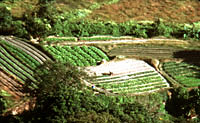 |
|
Tsui Kam-pui of Tai Long Wan village hoeing in his taro field. He owned a rotavator, but it seldom left the shed. |
 |
|
|
An old couple worked this Lantau hill farm (the old woman is working in the field in the centre). The beds descended right down the mountainside to the sea -- all done by hoeing.
|
|
|
|
|
|
|
|
|
|
Hoe for victory!
Gardeners dig (except no-dig gardeners), but most small farmers in the Third World use hoes, especially in the East. A Chinese peasant wouldn't have any use for a spade or a fork -- they remake the neat rows of beds in their fields several times a year, with a hoe. They work away at a relaxed, steady pace, and can do a whole field in a day. Once you've mastered a hoe, you won't want to use anything else.
Swiss hoes
This hoe is used by villagers in the high valleys of the Swiss Alps. Light, strong, sharp and well-balanced, such a hoe encourages a steady, tireless rhythm of work. We've had this one for 14 years, and it's as good as new.
|
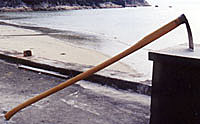 |
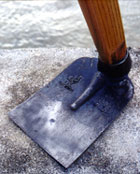 |
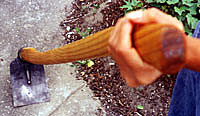 |
|
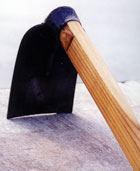 |
|
|
|
|
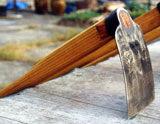 |
|
This hoe has a beautiful, shaped stock, like an elongated axe handle, great to use. It also came from the Swiss mountains, fitted with a huge blade like a big shovel, weighing 5lb, used for digging potato beds. We removed the blade and replaced it with a standard 2lb blade from China, which was fitted for a round stock, not a flat one like this, so it's secured with two shims.
|
|
|
|
|
|
|
|
|
|
|
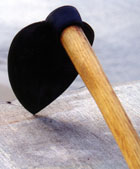 |
This pointed, heart-shaped hoe really bites into hard ground. We cut it to shape from a standard 2-1/2 lb hoe from China. The stock was somewhat warped (half-price!), which gives the hoe a better angle of attack. Stocks sold in Hong Kong are round, and heavy, so we narrowed it with a spokeshave to give a better grip and lighter weight. |
|
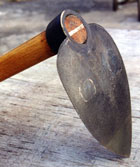 |
|
|
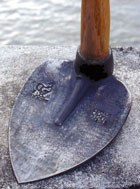 |
|
|
|
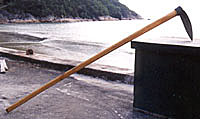 |
|
|
|
|
|
|
|
|
Other hoes
A 2lb hoe with the blade cut to 4 to 5 inches and serrated on the inside with a hacksaw makes a fine weeder, both chopping and tearing the weeds and mixing the shreds up with the surface soil to make a mulch. Angle the serrations one way on one half of the edge and the other way on the other, meeting in the middle in a V.
A 2lb hoe with the blade cut to a V-shape with a blunt, rounded point and the stock shortened to about 2ft is great for square foot gardeners -- ideal for loosening the topsoil of a single square foot and mixing in some compost after taking out a crop.
Hoe blades are bevelled on the OUTSIDE. Keep them sharp.
Fitting handles and stocks
In humid weather wood absorbs moisture and swells, when the weather's dry the wood dries out and shrinks. So the stock that was tight and solid in the wet season suddenly loosens when it's dry. Stand it in water overnight, and it will tighten again. Better, stand it in linseed oil. Best of all, use biodiesel.
If you fit the stock to the tool in the first place using Alexander Weygers's method, it will never come loose, rain or shine.
"Heat the handle socket to the point of scorching the wood, then quickly clamp the shovel in the vise and hammer the handle home. If you do not succeed on the first try because the handle does not match the socket curve well enough, you may have to preheat the end before hammering it into place. You can easily accomplish this heating by dipping the curved end in water and holding it in the flame until the water has evaporated and the wood begins to scorch. Repeat this operation maybe four or five times. Between the steam of the evaporating water and the heat of the fire, the entire curved end becomes heated to the core, momentarily making the wood limp. At the same time the handle socket should be heated to the point of scorching wood. Then quickly clamp the blade in the vise and hammer the limp handle into the socket. It will easily follow the curvature of the socket under the hammerblows on the other end of the handle. Following the curvature of the socket, the limp end flexes as if it were made of rubber." -- Alexander G. Weygers, "The Complete Modern Blacksmith", Ten Speed Press, 1997, ISBN 0898158966. Buy the book at Amazon.com: The Complete Modern Blacksmith
Hoe suppliers
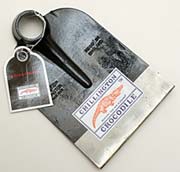 The Chillington Tool Company of England has been supplying quality hot-forged hoes for over one hundred years. Chillington hoes are sold throughout the world under a number of different brand names, the most famous being the "Crocodile".
The Chillington Tool Company of England has been supplying quality hot-forged hoes for over one hundred years. Chillington hoes are sold throughout the world under a number of different brand names, the most famous being the "Crocodile".
http://www.chillingtontoolsonline.co.uk/digging-hoes-and-handles-c1
In the US, EasyDigging.com supplies Grub Hoes, Grape Hoes, Azadas, and more made by British supplier The Chillington Tool Company.
http://www.easydigging.com/Tool/Chillington_Martindale.html
Chillington Tools distributor in Ireland and the UK, full range of hoes, sickles -- Chillington Hoes, Co. Mayo.
http://www.chillingtonhoes.com/
Bellotto Agricultural Tools of Brazil manufactures a wide variety of forged hoes, email export@bellotto.com.br
http://www.bellotto.com.br/br/produtos.php
Appropriate technology
Appropriate technology resources
- Agriculture resources
- Wood resources
Blacksmithing
Wood fires that fit
Houses that fit
Water-powered water pumps
Journey to Forever and AT
- Chinese watering cans
- Handmade Projects watering can plans
- Hoe for victory!
- Billhooks and sickles
A better rat trap
- Rats and owls
- Chinese rat trap
- How to make a Chinese rat trap
- Bucket rat trap
Appropriate technology subjects

Community development | Rural development
City farms | Organic gardening | Composting | Small farms | Biofuel | Solar box cookers
Trees, soil and water | Seeds of the world | Appropriate technology | Project vehicles
Home | What people are saying about us | About Handmade Projects
Projects | Internet | Schools projects | Sitemap | Site Search | Donations | Contact us

© Copyright of all original material on this website is the property of Keith Addison, unless otherwise stated. It may not be copied or distributed without the explicit permission of the copyright holder. All material is provided "as is" without guarantees or warranty of any kind, either expressed or implied.



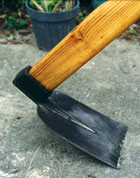
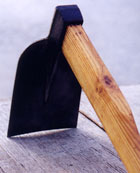
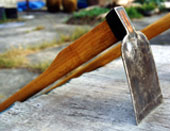
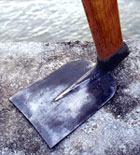









 The Chillington Tool Company of England has been supplying quality hot-forged hoes for over one hundred years. Chillington hoes are sold throughout the world under a number of different brand names, the most famous being the "Crocodile".
The Chillington Tool Company of England has been supplying quality hot-forged hoes for over one hundred years. Chillington hoes are sold throughout the world under a number of different brand names, the most famous being the "Crocodile".